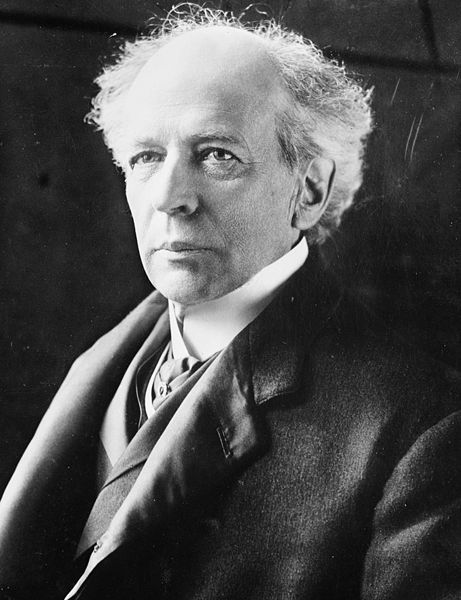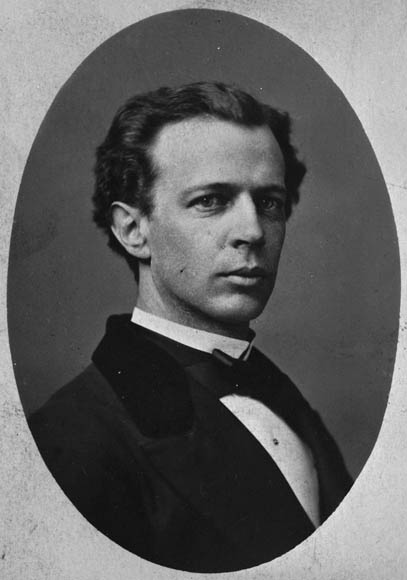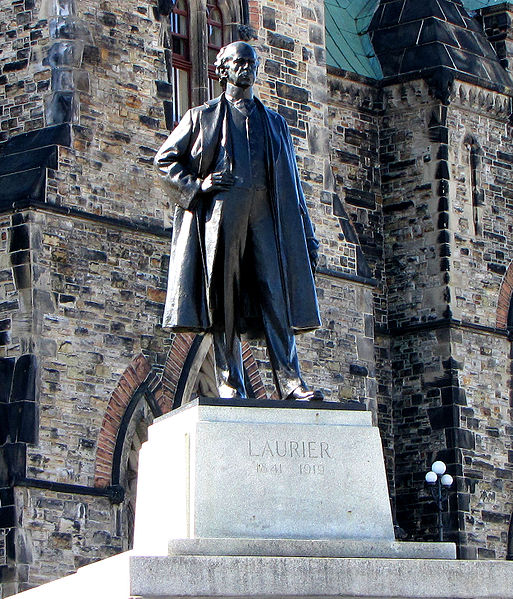<Back to Index>
- Astronomer Edwin Powell Hubble, 1889
- Painter Paulus Potter, 1625
- 7th Prime Minister of Canada Sir Wilfrid Laurier, 1841
PAGE SPONSOR



Sir Wilfrid Laurier, GCMG, PC, KC, baptized Henri-Charles-Wilfrid Laurier (20 November 1841 – 17 February 1919) was the seventh Prime Minister of Canada from 11 July 1896 to 5 October 1911.
Canada's first francophone prime minister, Laurier is often considered one of the country's greatest statesmen. He is well known for his policies of conciliation, expanding Confederation, and compromise between French and English Canada.
His vision for Canada was a land of individual liberty and
decentralized federalism. He also argued for an English-French
partnership in Canada. "I have had before me as a pillar of fire," he
said, "a policy of true Canadianism, of moderation, of reconciliation."
And he passionately defended individual liberty, "Canada is free and
freedom is its nationality," and "Nothing will prevent me from
continuing my task of preserving at all cost our civil liberty."
Laurier was also well regarded for his efforts to establish Canada as
an autonomous country within the British Empire,
though he supported the continuation of the British Empire if it was
based on "absolute liberty political and commercial". Laurier is the
fourth-longest serving Prime Minister of Canada, behind William Lyon Mackenzie King, John A. Macdonald, and Pierre Trudeau. A Maclean's historical ranking of the Prime Ministers placed Laurier third behind King (first) and Macdonald. Laurier also holds the record for the most consecutive federal
elections won (4), and his 15 year tenure remains the longest unbroken
term of office among Prime Ministers. In addition, his nearly 45 years
(1874 - 1919) of service in the House of Commons is an all-time record for that house. Finally,
at 31 years, 8 months, Laurier was the longest-serving leader of a
major Canadian political party, surpassing King by over two years.
Laurier's portrait is displayed on the Canadian five-dollar bill. The second child of Carolus Laurier and Marcelle Martineau, Wilfrid Laurier was born in Saint-Lin, Canada East (today called Saint-Lin-Laurentides, Quebec) on 20 November 1841. Laurier was the 7th generation of his family in Canada. His ancestor François Cottineau, dit Champlaurier came to Canada from Saint-Claud, France. He grew up in a family where politics was a staple of talk and debate. His father, an educated man having liberal ideas, enjoyed a certain degree of prestige about town. In addition to being a farmer and surveyor, he also occupied such sought-after positions as mayor, justice of the peace, militia lieutenant and school board member. At the age of 11, Wilfrid left home to study in New Glasgow, a neighbouring village largely inhabited by immigrants from Scotland.
Over the next two years, he had the opportunity of familiarizing
himself with the mentality, language and culture of British people.
Laurier was first elected to the Canadian House of Commons in the 1874 election, serving briefly in the Cabinet of Prime Minister Alexander Mackenzie as Minister of Inland Revenue. The Laurier Museum, the
home of former Prime Minister, Sir Wilfrid Laurier is on the Canadian
Register of Historic People and Places. The house was built in 1876 in Victoriaville, Quebec. Chosen
as leader of the Liberal Party in 1887, he gradually built up his
party's strength with his personal following in Quebec and elsewhere in
Canada. He led the Liberal Party to victory in the 1896 election, and remained prime minister until the party's defeat in the 1911 election. Laurier was able to build the Liberal Party a base in Quebec, which had been a Conservative stronghold for decades due to the province's social conservatism and the influence of the Roman Catholic Church, which distrusted the Liberal's anti-clericalism. He was aided by the growing alienation of French-Canadians from the Conservatives due to the national Tory party's links with anti-French, anti-Catholic Orangemen in English Canada. These factors combined with the collapse of the Conservative Party of Quebec gave
Laurier an opportunity to build a stronghold in French Canada and among
Catholics across Canada. Because Laurier believed in a separation of church and state, Roman Catholic bishops in Quebec repeatedly warned their parishioners never to vote for the man. Journalist and author Laurier LaPierre wrote
in his 1996 biography of Laurier: "children were made to kneel and beg
God that their parents not be damned should they have the temerity to
vote for the Liberal candidate. When electors asked directly whom they
should vote for, the cagey priests contented themselves with informing
them that le ciel est bleu, l'enfer est rouge – heaven is blue, hell is red." However, Laurier had rather good relations with Pope Pius X himself,
and had complimented him during a diplomatic meeting. In part, the
tension of the time can be attributed to Pius's encyclical Vehementer Nos, which condemned strict Church-State separation in Émile Combes' secularist France. Laurier led Canada during a period of rapid growth, industrialization, and immigration. His long career straddles a period of major political and economic change. As Prime Minister he was instrumental in ushering Canada into the 20th century and in gaining greater autonomy from Britain for his country. One of Laurier's first acts as Prime Minister was to implement a solution to the Manitoba Schools Question, which had helped to bring down the Conservative government of Charles Tupper earlier
in 1896. The Manitoba legislature had passed a law eliminating public
funding for Catholic schooling (thereby going against the federal
constitutional Manitoba Act, 1870, which guaranteed Catholic and
Protestant religious education rights). The Catholic minority asked the
federal Government for support, and eventually the Conservatives
proposed remedial legislation to override Manitoba's legislation.
Laurier opposed the remedial legislation on the basis of provincial
rights, and succeeded in blocking its passage by Parliament. Once
elected, Laurier proposed a compromise stating that Catholics in Manitoba could
have a Catholic education if there were enough students to warrant it,
on a school-by-school basis. This was seen by many as the best possible
solution in the circumstances, making both the French and English
equally satisfied. In 1899, the United Kingdom expected military support from Canada, as part of the British Empire, in the Second Boer War.
Laurier was caught between demands for support for military action from
English Canada, and a strong opposition from French Canada which saw
the Boer War as an "English" war and to some degree appreciated the
similar places that Boers and French Canadians held in the British
Empire. Henri Bourassa was an especially vocal opponent. Laurier eventually decided to send a volunteer force, rather than the militia expected by Britain, but Bourassa continued to oppose any form of military involvement. In 1905, Laurier oversaw Saskatchewan and Alberta's entry into Confederation, the last two provinces to be created out of the Northwest Territories. On 29 July 1910, while in Saskatoon to attend the opening of the University of Saskatchewan, he bought a newspaper from a young John Diefenbaker,
a future Conservative Prime Minister. The young Diefenbaker,
recognizing the Prime Minister, shared his ideas for the country and
amused him. He inquired about the young man's business and expressed
the hope that he would be a great man someday. The boy ended the
conversation by saying, "Well, Mr. Prime Minister, I can't waste any
more time on you. I must get back to work." The naval competition between the United Kingdom and the German Empire escalated
in the early years of the 20th century. The British asked Canada for
more money and resources for ship construction, precipitating a heated
political division in Canada. The British supporters wished to send as
much as possible, whereas those against wished to send nothing. Aiming
for compromise, Laurier advanced the Naval Service Bill of 1910 which created the Royal Canadian Navy. The navy would initially consist of five cruisers and six destroyers; in times of crisis, it could be made subordinate to the Royal Navy proper. The idea was lauded at the Imperial Conference on Defence in London,
but it proved unpopular across the political spectrum in Canada,
especially in Quebec as ex-Liberal Henri Bourassa organized an
anti-Laurier force. Another controversy arose regarding Laurier's support of trade reciprocity with the United States.
This had the strong support of agricultural interests, but it alienated
many businessmen who formed a significant part of the Liberals' support
base. The Conservatives denounced
the deal as a sell-out, even playing upon fears that Canada would be
assimilated as the next US state. Despite the Liberal government's
mandate not expiring, Laurier called an election to settle the issue of reciprocity. The Conservatives were victorious and Robert Laird Borden succeeded Laurier as Prime Minister. Laurier led the opposition during World War I. He led the filibuster to the Conservatives' own Naval Bill which would have sent contributions directly to the Royal Navy; the bill was later blocked by the Liberal-controlled Senate. He was an influential opponent of conscription, which led to the Conscription Crisis of 1917 and the formation of a Union government, which Laurier refused to join for fear of having Quebec fall in the hands of nationalist Henri Bourassa. However, many Liberals, particularly in English Canada, joined Borden as Liberal-Unionists and the "Laurier Liberals" were reduced to a mostly French-Canadian rump as a result of the 1917 election.
However, Laurier's last policies and efforts had not been in vain. As a
result of Laurier's opposition of conscription in 1917, Quebec and its
French-Canadian voters voted overwhelmingly to support the Liberal
party starting in 1917. Despite one notable exception in 1958, the Liberal party continued to dominate federal politics in Quebec until 1984. His protege and successor as party leader William Lyon Mackenzie King led the Liberals to a landslide victory over the Conservatives in the 1921 election. Laurier died of a stroke on 17 February 1919, and was buried in Notre Dame Cemetery, Ottawa, Ontario. The Sir Wilfrid Laurier National Historic Site of Canada is in Saint-Lin-Laurentides, a town 60 km north of Montreal. His wife Zoe Laurier died in 1921 and was buried in the same grave as Lady Laurier. Another site is Laurier House, his residence in Ottawa at the corner of what is now Laurier Street and Chapel Street. In their will, the Lauriers left the house to Mackenzie King, who in turn donated it to Canada upon his death.